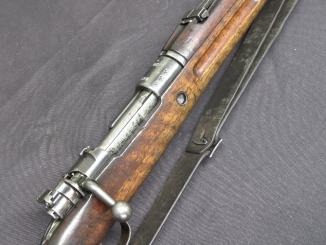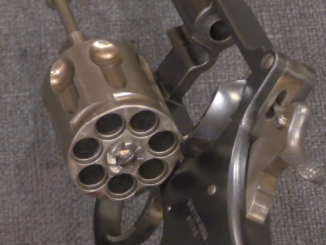Josef Schulhof was the the first and most prolific designer of manually operated pistols in Austria in the 1880s. For a brief few years, there was a lot of developmental work done in this field, comparable really only to the American Volcanic system. The Austrian pistols were more practical, and as they still predated the development of any practical self-loading pistols, there was a chance that they could have become commercially relevant. This did not actually happen, of course, as any advantages they offered over revolvers were still better in the crop of self-loaders that emerged in the late 19890s.
Schulhof’s first pistols were patented in 1884, and he experimented with a variety of locking system and magazine systems. This example is an 1887 type, with a spring-loaded rotating bolt and a 6-round rotary magazine. It was intended to be fired from an open bolt, rather like a double-action revolver – but it could be carried with the chamber loaded an a manual safety engaged.




Love the elegant lines and details.
I am awed by the ingenuity and elegance of this design – which fully feasible, though its complexity (including to manufacture) a problem. Sadly its unfortunate timing doomed it to a steam punk type also ran, that would have had a brighter future / successors if handguns hadn’t almost immediately radically changed.
It’s interesting that semiautos made this type of manual repeater (but not revolvers, which are less advantageous in some ways) obsolete. Also, that this type of trigger lever never became popular for revolvers.
I think there’s three factors that might play into this.
For one, that whole trigger-ring setup, while awfully cool, also adds a good deal of complexity to a design, affecting price and reliability of the arm.
And as a second matter, I think for purposes of safety (at least by current day standards) it’s much preferable to be able to operate/cycle the arm without having to get your finger anywhere near the trigger.
And third, I feel as if it’s a lot more comfortable to cock a hammer with your thumb, a fairly strong finger that can get good purchase on the hammer spur, as opposed to do performing a push-pull motion with the index finger.
Those are my suspicions. For whatever reason these never took off, it is a bit of a shame since they’re so cool. Though maybe we’d be saying the same about traditional revolvers if they had… 😉
Seiden,
1. Without a detailed look inside the Schulhof itself I can’t agree or disagree about its complexity. Overall, lever actions rose from pistol beginnings to dominate the US rifle market for a long time. While several factors have driven up their price today, my lever rifle cost a good bit less than the Glock (a paragon of simplicity) that I bought around the same time. Whatever reason lever-action didn’t become popular in pistols (I’d guess the poor performance of the originals with “rocket ball” ammo; possibly also reduced capacity with the COAL needed for performance in the 19thC), it wasn’t price or reliability.
2. Easily addressed (as in most other leverguns) by adding a loop for the second finger. Besides, “current day standards” didn’t exist 150 years ago.
3. A matter of personal preference, but I think it’s more comfortable to operate controls with fingers that are next to them while in firing position. Practically everyone who designed a non-replica firearm in the last 100 years seems to agree.
Ian forgot to scrub the evidence of his time traveling again – wonder what’s happening in 19890 that is going to make handguns totally obsolete?
In that year, you kill people by deleting their data in the cloud.
This is a phenomenal design; so much accomplished in such tight space. The functionality is superb and I do not see it as that difficult to make.
Most entertaining part is about Mrs.Schulhof as she carried on with her husband’s task. They did not have at that time female engineers yet, did they? (let’s hope I don’t snatched for this remark) 🙂
Marie Curie and Bertha Benz were around.
Schulhof really wss a fascinating personality – engineer, inventor etc. Alas, there isn’t a lot to read about him (online).
Only two German links are worth mentioning:
https://de.wikipedia.org/wiki/Josef_Schulhof
http://www.biographien.ac.at/oebl/oebl_S/Schulhof_Josef_1824_1890.xml
Very much worth of reading. Take machine translator, its really captivating.
“Alas, there isn’t a lot to read about him (online).”(С)
As well as about dozens of other inventors and handicraftsmen.
http://www.american-firearms.com/american-firearms/Manufacturers/START.html
This is similar to the emergence of CNC machines a century later.
Equipment and materials have become available, allowing everyone (who has one) to embody any engineering fantasies.
Time itself adjusted everything.
All sorts of outlandish monsters died out without any outside interference.
History repeats itself today, with all sorts of amazing cockroach-giraffe hybrids.
Imagine this design scaled up into a carbine chambered for .22 lr or WMR.* It would appeal to European and American small game hunters/plinkers if nobody else, and that’s a big market right there. Of course, it would sell best if styled like a genuine Schulhoff, with nice checkering and old-fangled lines. I’m tired of plastic, aren’t you?
* I want mine in .25-20. .32-20 for my second order.
I love the .22 idea. Make my centerfire a 10mm 🙂
Are you obsessed with “Magnum force” and/or big irons? I haven’t seen any action cops or Sheriffs around here…
Schulhof did design a rotary-magazine bolt-action rifle that was tested by the United States Army in 1889;
https://www.forgottenweapons.com/1889-schulhof-rotary-magazine-bolt-action-at-ria/
He also designed a rifle on the same general principle as the 1887 pistol. What’s interesting is that what he basically came up with was a lever-action rifle with a rotary-type box magazine and a rotating-bolt locking system. All about seventy years before the Winchester Model 88 and Sako Finnwolf.
Imagine what would have happened if his wife had sold the rights to Winchester, and John Moses Browning had noticed its potential for safely accommodating very high-pressure cartridges, as with 1950s lever gun designs.
Then imagine T.R. getting interested.
cheers
eon
“T.R.”
What organization is hiding under that acronym?
Pretty sure he means President (prior militia colonel, adventurer, hunter, and all-around “gun guy”) Theodore Roosevelt.
Yep. TR was a bit ambivalent about the Model 1895 in .30-06 or .405 WCF due to its tendency to frame stretch with the high-pressure rounds. Schulhof’s rotary-bolt action, even though rear-locking rather like the SMLE, probably wouldn’t have had that problem.
A “Schulhof/Browning” Winchester lever gun in .405 or the later, even more intense .348, would probably have brought a smile to Roosevelt’s face.
cheers
eon
“I’m tired of plastic, aren’t you?”
If you want to non-automatic magazine polymer-less pistol firing modest (by modern standards) cartridge then just get FRANCOTTE, see images: http://historypistols.ru/blog/pistolety-pod-unitarnyj-patron-nesamozariydnie/pistolet-frankotta-francotte-repeating-pistol/
Hmm…
It looks like more than a single one was made…
https://s00.yaplakal.com/pics/pics_original/9/1/2/8610219.jpg